Dairy producers must have an understanding of reproductive physiology when they are developing new techniques to improve fertility. Using this knowledge, they can realize an increase in the pregnancy rate of their dairy herds. In all dairies, reproductive success leads to a decrease in days in milk (DIM) and an increase in the number of replacements. For seasonal herds, maintaining a 12-month calving interval (CI) is vital. Therefore, reproduction is vital. This publication gives a summary of the cow’s reproductive structure and its more critical hormones, plus various ways to get cows and heifers pregnant.
Basic physiology
The length of time between one heat and the next heat marks the estrous cycle. Cows normally cycle every 21 days, but the cycle can range from 18 to 24 days. The modern Holstein tends to have slightly longer estrous cycles. The estrous cycle is affected by two structures on the ovary: the follicle and the corpus luteum. The follicle houses the egg, which if ovulated (released) and if fertilized has the potential to be the next offspring. Each ovary usually has more than one follicle, and these follicles develop in waves. Cells making up the integrity of the follicle produce a hormone called estrogen. Estrogen is responsible for the increased activity (mounting, standing, walking and bawling) associated with estrus (heat). Estrogen concentrations increase and decrease with the growth and regression of the dominant follicles, peaking at the time of heat.
The corpus luteum, a mass of endocrine tissue, develops from the ruptured follicle after ovulation. Its main purpose is to secrete the progesterone necessary to maintain pregnancy. If the cow does not become pregnant, a release of prostaglandin-F2a (PGF2a) from the uterus around day 15 to 18 post-heat causes regression of the corpus luteum so the animal can return to heat. The heat cycle begins with the release of follicle stimulating hormone (FSH), which is responsible for the “recruitment” of each wave of follicles. Most cows have two follicular waves (Figure 1). Generally, several follicles are recruited for each wave from a pool of tiny follicles. The recruited follicles then deviate: one grows and becomes the dominant follicle, inhibiting the growth of the others. If not ovulated, the dominant follicle loses its dominance and undergoes atresia (dies), ending the first wave of the cycle, and the second wave begins with recruitment of a new wave of follicles. Generally, a single follicle ovulates shortly after the end of heat. Less than 1 percent of follicles have the opportunity to ovulate.
Ovulation is initiated by a surge of luteinizing hormone (LH) from the pituitary gland. Gonadotropin releasing hormone (GnRH) from the hypothalamus stimulates the release of LH. Injection of Cystorelin, Factre, Fertagyl or Ovacyst, causes the release of LH and results in ovulation or luteinization of a nonovulated follicle or cyst. A release of PGF2a from the uterus around day 15 to 18 post-heat causes regression of the corpus luteum if the cow does not become pregnant. Cows display estrus three to six days after corpus luteum regression. This correlates to a 21-day estrous cycle. Injection of Estrumate, Estroplan, Lutalyse, or Prostamate, like the cow’s natural release of PGF2a from the uterus, causes the destruction of any corpus luteum or viable luteal tissue.
With an understanding of the role of reproductive hormones, producers can modify their reproductive management programs to fit their needs.
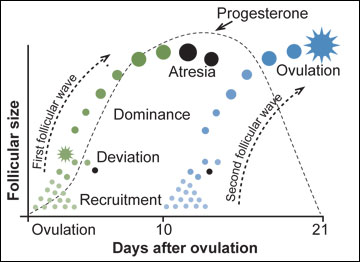 Figure 1. Most cows have two follicular waves during a heat cycle, after which a single follicle ovulates.
Figure 1. Most cows have two follicular waves during a heat cycle, after which a single follicle ovulates.
Heat detection
An important step in getting cows bred and pregnant is accurate heat detection. Heat detection often is taken for granted or put off in favor of other chores that must be done. In many instances, cows are labeled as “won’t come in heat,” or anestrous, when the problem may be the timing of detection. Many dairy cows ovulate within three weeks post-calving, and most cows have ovulated at least once by the voluntary waiting period (VWP) of 50 to 60 days post-calving. In a research trial, 24-hour television surveillance observed 90 percent of cows in heat, yet producers detected only 50 percent. Nationally, the average annualized Heat Detection Rate (HDR) is only 35 to 40 percent. However, due to advances in reproductive management practices, the HDR of elite herds is over 60 percent. An increase of 20 percent in heat detection can be achieved by simply moving the time cows are checked, such as from 8 a.m. to 6 a.m., or by adding a third heat detection period, such as checking at 6 a.m., noon and 6 p.m.
Factors affecting “heat watch”
Most cows (70 percent) display heat in late evening or early morning. Therefore, heat watch should happen at these times and not at feeding or milking times.
The number of animals in heat may influence the “strength” of heat. In one observation, the number of mounts increased from 11.2 per cow when one cow in the herd was in heat to 52.6 per cow when three cows in the herd were in heat. Ground surface also affects mounting. Researchers have observed nearly twice as many heats from cows on dirt versus concrete, which is advantageous for pasture-based herds.
Using and maintaining records
A successful breeding program begins with keeping good records. Records should include calving dates, all heats, breeding dates and any hormonal therapies administered. To obtain good records, watching for heat in cows at least twice a day for a minimum of 30 minutes each watch is crucial. Make observations when other activities are not occurring or when cows are free to interact. Avoid observing for heat when feeding cows.
Heat-detection tools
Heat-detection aids are beneficial for identifying cows in heat. Such tools include KaMar capsules, paint sticks or chalk, and Estrotect patches. The KaMar capsule works by changing from white to red as cows are mounted. The paint stick or chalk works by being smeared or worn off as a result of mounting. The Estrotect patches act as a scratch-off pad; as the animal is ridden, the gray covering is removed to reveal the color of the patch. Electronic heat-detection methods, such as HeatWatch, measure the activity of the cow, the number of mounts, or both. Electronic methods are more costly in initial setup and maintenance. All of these tools are beneficial in detecting heat, but they are only tools and cannot replace good visual heat detection and good records (Figure 2).
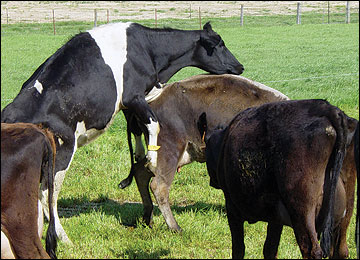 Figure 2. A cow's behavior, such as standing to be ridden, is a reliable indicator of estrus.
Figure 2. A cow's behavior, such as standing to be ridden, is a reliable indicator of estrus.
Heat synchronization
A successful heat-synchronization program has three requirements: all cows cycling normally, good records, and a commitment to both heat detection and a timely breeding program. With an understanding of these requirements, producers can successfully design a program to fit their own situation. This section covers some basic protocols and explains why they work and when they won’t.
Basic protocols
To synchronize heat in a herd, estrus must be artificially induced. In the United States, the only drug approved for artificially inducing heat in a lactating dairy herd is prostaglandin-F2a (PGF2a). PGF2a is a naturally occurring hormone released from the uterus in the absence of a pregnancy at day 14 to 18 post-heat. This release causes the demise of the corpus luteum and returns the cow to heat. The use of PGF2a has limitations because PGF2a is effective only in cycling cows from day 5 to 15 of the estrous cycle (Figure 3).
Many producers use PGF2a to aid in their breeding programs. The most common method is simply to inject all cows available to be bred, excluding pregnant cows (Figure 4). More than 60 percent of the cows should display heat if all cows are cycling normally. All of the cows will not display heat because 30 to 40 percent of the cows were day 1 to 5 post-heat, and PGF2a will not affect the developing corpus luteum in these cows. Cows in the 15- to 20-day range will express heat not due to the injection of PGF2a but due to the natural release of prostaglandin.
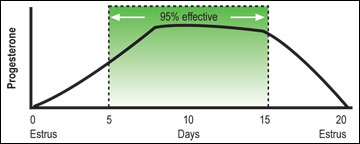 Figure 3. Effectiveness of PGF2a throughout the estrous cycle of the cow.
Figure 3. Effectiveness of PGF2a throughout the estrous cycle of the cow.
 Figure 4. Single injection of PGF2a protocol and response.
Figure 4. Single injection of PGF2a protocol and response.
Monday program
The “Monday program” requires PGF2a to be administered every other Monday and then for cows to be bred during the middle of the week. The Monday program avoids reproductive management over the weekend when family plans or the absence of hired labor may interfere with good, sound heat-detection and breeding practices.
By using two injections of PGF2a, potentially 100 percent of the cows will display heat (Figure 5). However, producers may choose to use only one injection of PGF2a to lower costs. Producers may choose to detect heat, then either inseminate cows or turn in bulls for four to six days. Then they can administer PGF2a only to cows not bull-bred or artificially inseminated (Figure 6a).
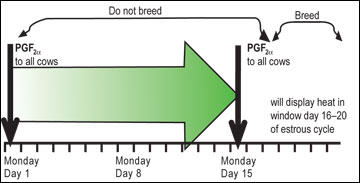 Figure 5. The "Monday program": Two-shot PGF2a protocol and response.
Figure 5. The "Monday program": Two-shot PGF2a protocol and response.
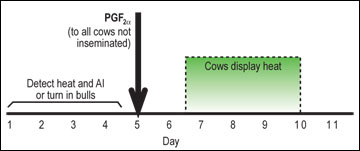 Figure 6a. Using PGF2a to minimize costs.
Figure 6a. Using PGF2a to minimize costs.
Southwest Center Protocol
The Southwest Center Protocol is a modification of the Monday program used to presynchronize or synchronize a herd. The protocol begins 24 days before the start of the mating season. At -24 days, all eligible cows would receive a PGF2a injection and be checked for heat. Any cows that display heat during this week should now return to estrus naturally at day 0 (start of mating). One week later (-17 days), any cow that had not shown heat would receive a second PGF2a injection and be checked for heat. One week later (-10 days), any cow that still has not shown heat would be put on an Ovsynch/CIDR protocol (described below). If the herd responds appropriately, the cows on the Ovsynch/CIDR program would be timed artificially inseminated (TAI) the first week of the breeding period along with the cows that responded to the first PGF2a. The cows that responded to the second PGF2a should be in heat the second week of the breeding period. Alternatively, if the producer wishes all cows to be inseminated the first week of breeding, a third shot of PGF2a can be administered at day -3 to the group of cows that responded to the day -17 PGF2a injection (Figure 6b).
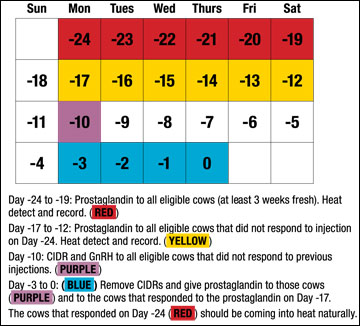 Figure 6b. The Southwest Center Protocol, developed by Stacey Hamilton, University of Missouri Extension.
Figure 6b. The Southwest Center Protocol, developed by Stacey Hamilton, University of Missouri Extension.
Ovsynch (+/- a CIDR) program
In the older system, an injection of PGF2a caused the regression of the corpus luteum and initiated a new heat within a few days. However, follicular development was variable. Cows with large follicles that are nearing dominance may display heat sooner than other cows because an ovulatory-sized follicle is already present. These cows do not need to recruit and develop a new follicular wave and resulting ovulatory follicle. Cows that do not have a dominant follicle present will take longer to show a heat.
Ovsynch is based on synchronizing follicular waves as well as manipulating corpus luteum function. Thus, Ovsynch does not require heat detection. Cows are treated with an injection of GnRH. Seven days later, cows receive an injection of PGF2a. A dominant follicle is already present. A second injection of GnRH is administered 56 hours after PGF2a. Insemination is timed for all cows 16 hours after the second GnRH injection (Figure 7).
Now that CIDRs are available, they can be incorporated into the Ovsynch program. The CIDR would be inserted into the female at the time of the first GnRH injection. Then, the CIDR is removed at the time of the PGF2a injection. The advantage of the CIDR is that it increases the number of anestrous cows that will cycle and get pregnant. However, it does not necessarily increase the pregnancy rates of cycling cows. Therefore, if you are recording pre-mating heats and a high percentage of cows are cycling, a CIDR may not benefit pregnancy rates, but if few cows are cycling, the CIDR will be valuable.
Pregnancy rates for this program are similar to conventional methods of using PGF2a as the only synchronizing hormone. Producers must be aware that the Ovsynch program does not work well on virgin heifers. Follicular development in heifers seems to be different from that of lactating cows. Heifers tend to have more three-follicular wave cycles than cows. Thus, Ovsynch may not work well on heifers.
Some producers have adapted this program to fit their operations by using the hormonal setup but continuing to check for heat and breeding only cows seen to stand. Although this may save producers in semen costs, it will cost them in total pregnancies.
As stated before, producers must evaluate these programs, calculate the costs associated with them, and adopt or adapt the program to fit their objectives. Programs to synchronize estrus are not difficult to practice; however, they do require a commitment to detail from the producer.
To view the latest recommended synchronization protocols, visit the Dairy Cattle Reproduction Council website, http://www.dcrcouncil.org.
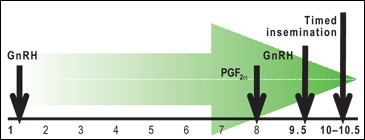 Figure 7. Ovsynch program protocol.
Figure 7. Ovsynch program protocol.
Heifer synchronization protocols
The effect on conception of estrus synchronization programs designed for heifers should be evaluated. Note that these protocols using melengestrol acetate (MGA) are not approved for lactating dairy cows. Feeding heifers MGA (0.5 mg/hd/day) for 14 days and injecting them with prostaglandin (PG) 17 days after MGA feeding ends (MGA-PG protocol) is an effective method of estrous cycle control (Figure 8). MGA, a synthetic progestin, mimics the effects of progesterone secreted by the corpus luteum during the luteal phase. These high levels of progesterone inhibit preovulatory follicular maturation and ovulation. Stopping the MGA feeding reduces progesterone concentrations and allows follicular maturation to continue with eventual ovulation of the dominant follicle (within 3 to 6 days) and formation of a corpus luteum. A heat will follow MGA removal; however, this heat is subfertile. The injection of PGF2a 17 days after MGA feeding ends destroys the corpus luteum, resulting in estrus (within 2 to 3 days), which is a fertile heat.
Sole use of MGA feeding has resulted in reduced fertility in treated heifers. The MGA-PGF2a protocol avoids problems with reduced conception and offers advantages over untreated controls.
Studies show that fertility is higher at second service than at first service after MGA in MGA-treated Holstein cows and higher than that at both first and second services for untreated herdmates. These data indicate that the second synchronized estrus after MGA, whether spontaneous or induced with PGF2a, may be inherently more fertile.
The MGA-PGF2a system has the following disadvantages:
- Anestrous beef cows that experience a short luteal phase after the period of MGA feeding, which in some cases necessitates a second PGF2a injection;
- The potential for an increased incidence of twinning, which is undesirable from a management viewpoint in many production systems;
- A relatively long treatment period.
Recent studies with heifers show that both synchrony of estrus and total estrus response are greater when PG is administered 19 days after MGA withdrawal than when heifers are injected on day 17 after MGA withdrawal. Use of MGA in conjunction with PGF2a injection in synchronizing dairy heifers can be an effective method for dairy producers when grouping heifers for breeding or calving window.
Some producers will use the “Monday program” described above. The use of PGF2a is effective because a majority of dairy heifers are cycling at the start of the breeding period. In several studies conducted by University of Missouri (MU) researchers with Holstein, Jersey and Holstein/Jersey cross cows, less than 10 percent of the heifers had reproductive tract scores (RTS) of less than 4 before the start of breeding. The RTS is a rating system of the development of the reproductive tract of yearling heifers. The scale is from 1 to 5:
- Reproductive tract is infantile.
- Heifer has small follicles on its ovaries.
- Follicles are near 8 to 10 mm in diameter.
- Heifer is near a heat.
- Heifer has a corpus luteum, so has reached puberty and is cycling .
Heifers with a score of 4 or 5 have the highest conception rates and are equally likely to become pregnant. Heifers with lower scores are less likely to become pregnant.
Likewise, MU researchers have investigated the use of a 14-day CIDR program in dairy heifers. This protocol has been published for its use in beef heifers. The protocol involves the following steps:
- Insert a CIDR, leave it in for 14 days, then remove it.
- Sixteen days later, inject the heifers with PGF2a.
- Sixty six hours later, timed artificially inseminate (TAI) the heifers and give them an injection of GnRH.
 Figure 8. MGA and prostaglandin protocol for synchronizing heifers.
Figure 8. MGA and prostaglandin protocol for synchronizing heifers.
Pregnancy testing
Once cows have been AI or bull-bred, producers can benefit from determining which cows are pregnant. Historically, veterinarians have rectally palpated cows for pregnancy. Experienced veterinarians can determine pregnancy as early as 30 to 35 days after breeding. Today, a veterinarian can use ultrasound for pregnancy diagnosis. The ultrasound increases the veterinarian’s accuracy of aging the pregnancy and lessens the time to pregnancy determination (25 to 30 days after breeding). Likewise, several chemical pregnancy tests are available for producers to use. Like the ultrasound, these tests can determine pregnancy early, but they do not age the gestation.
Seasonality issues
Seasonal calving is the practice of calving all cows and heifers in a relatively short window (60 to 90 days) and drying off all animals within a few weeks of one another. This practice can allow producers 30 to 60 days away from the dairy because all animals are dry at the same time. With seasonality, the breeding season also becomes an opportunity. Producers can focus on heat detection and breeding for the same length of time as their calving season (two to three months).
An important concept to keep in mind is that seasonality and grazing are not the same. While a grazier would more likely select this management practice to fit family and business objectives, dairy producers using more conventional management methods could also use seasonality in their operations.
The use of PGF2a also may be a necessity for seasonal breeding and calving. Artificial insemination is generally used for one to four weeks and is followed with use of herd-cleanup bulls. The main objective is pregnant cows. Artificial insemination allows the genetic progress to continue, and the use of bulls helps ensure additional cows are pregnant in the calving window (Figure 9).
Calving in a short window also allows producers to manage baby calves in groups and for only six to eight weeks longer than the calving season (with a 6- to 8-week weaning program). An overall reduction in labor as a result of managing baby calves for only four to five months is enticing to many producers. The reduction of labor allows producers to focus on other management areas or spend more time with their families. Seasonal calving also may aid producers in developing heifers because all animals are of similar size and age.
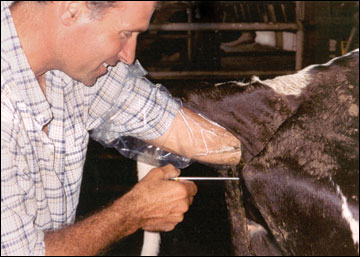 Figure 9. Artificial insemination allows a producer with a small herd to use genetically superior bulls.
Figure 9. Artificial insemination allows a producer with a small herd to use genetically superior bulls.
Selecting a calving window
Producers must consider many aspects of their operations when evaluating seasonality as a potential management practice. One of the most obvious is the selection of a calving window. Most graziers in the fescue belt and north choose to calve in late winter through early spring (February to April) to match the cows’ peak milk production and dry matter intake with peak forage quality and production. The spring calving also allows producers to avoid milking in part of winter. It can also reduce the amount of forage and grain inputs throughout the entire year. However, producers who choose to freshen from February to April may experience increased difficulties in reproductive performance, a decline in milk production and increased early embryonic mortality due to heat stress in the summer, depending on their geographical location. Proper management practices such as providing adequate shade, using ventilation or other cooling devices and developing feeding strategies can reduce the potential reduction in milk. If producers use these management practices, conception and pregnancy rates may not decline to summertime fertility levels as expected. Ensuring plenty of water and high-quality forage in the form of hay, balage or grass near the loafing shade areas is crucial for maintaining dry matter intake and milk production. Slightly disturbing cows in the shade during the heat of the day can encourage some cows to forage for 30 to 60 minutes or drink more water rather than lie in the shade. Management practices dealing with heat stress can have a positive effect on cow performance and make this time of year more enjoyable.
Other producers select fall as the time of year to freshen. Fall offers more moderate weather to calve and little or no heat stress to hinder milk production and breeding. However, producers may be forced to negotiate the difficulties of winter, depending on their location. Inclement weather may result in increased mastitis and frozen teats as well as being uncomfortable for the producer. The most important aspect to consider is the increased cost of feeding. Cows will peak in milk production and dry matter intake when grass may not be available, so mechanically harvested forages will need to be fed. In southern parts of the U.S., winter annuals may be grown to help alleviate this potential problem and provide a high-quality pasture forage for cows in peak lactation. Many of these harvested forages will not equal the quality of forage available to cows in a well-managed grazing system, and additional grain may need to be fed to supplement the forage. Producers may see benefits of typically higher milk prices in the fall and winter. However, the dramatic swings in milk prices may no longer be as seasonal as once thought. Fall freshening based on milk prices will need to be investigated further as the dairy industry explores milk-pricing structures. Producers must determine what price advantage they need to accommodate the increased feed bill they will have over spring calving.
Dairy producers need to base their seasonal-milking decisions on their goals. Producers with school-age children may consider the fall timing better for their families as the dry-off period corresponds with school vacation. Others may take time off during the winter by drying off then and having someone else manage the dry cows. Simply put, a calculator, pencil and paper and the producer’s goals are what will determine if seasonal dairying is an option and, if so, when the season should be.